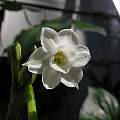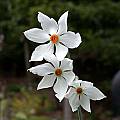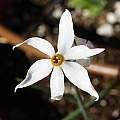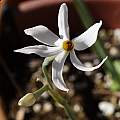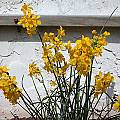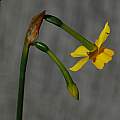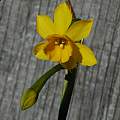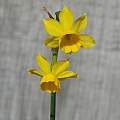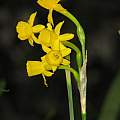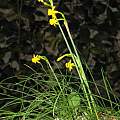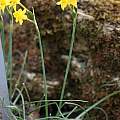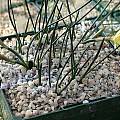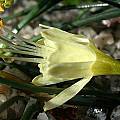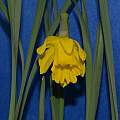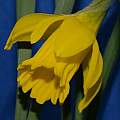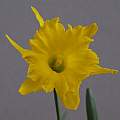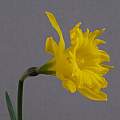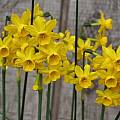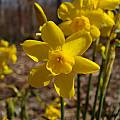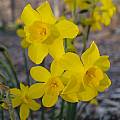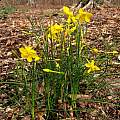Q Narcissus is a genus in the Amaryllidaceae family native to Europe, North Africa and Asia. As a popular garden plant it has been hybridized heavily, and there are new ones being introduced every year. Among all of the attention focused on the hybrids, species Narcissus tend to be overlooked. That's a shame, since many of the species have a delicate charm of their own.
Unfortunately, the naming of species Narcissus is a mess. Bulb expert Brian Mathew reports that they can be difficult to classify, with various authors identifying anywhere from 26 species to more than 60. Because Narcissus have been in cultivation for so long, some plants believed to be species are known only in gardens, with no known wild populations to verify them. All of this confusion is reflected in commerce, where bulbs may be sold under a variety of different names. We've done our best to classify the following photos, but this page is definitely a work in progress. Please let us know if you find an error. The species d-j will be found below.
Note: The letter and number codes after each species name refer to Brian Mathew's taxonomy of Narcissus species, which you can read here.
Narcissus dubius. 2a(i)B N. dubius is a spring blooming tazetta-like species native mostly to limestone rock pockets in the eastern portion on the Iberian Peninsula in southeastern Spain and the southern tip of France. The flowers, less than an inch in diameter, are white, held on a relatively long flower tube on a scape less than ten inches tall. The segments are best described as 'acorn-shaped', are somewhat backswept, and about equal in length to the cup. As many as eight flowers can be held per umbel from each bulb. The flat dark green leaves grow to an out-of-proportion length of twenty inches or more. N. dubius has been suggested to be a hybrid between N. assoanus and N. papyraceus based on genetic studies. Photograph by Arnold Trachtenberg.
Narcissus elegans. 2a(ii). Autumn-flowering bulbs with narrow leaves and very shallow coronas. Up to seven tiny flowers in an umbel. Petals white or greenish, corona is green, brownish, or orange. Height: to 15 cm. Italy and North Africa. First photo by John Lonsdale, photos two and three by Michael Mace.
Narcissus elegans var. elegans forma auranticoronatus: orange corona.
Narcissus elegans var. elegans forma elegans: narrow white petals and green corona.
Narcissus elegans var. fallax: pointed, green-white petals.
Narcissus elegans var. flavescens: pointed, cream-colored petals.
Narcissus elegans var. intermedius: wider petals.
Narcissus fernandesii. 1d(i) - green-leaved jonquils. Up to four flowers per umbel, curved tube. Portugal-Spain. Very similar to Narcissus cordubensis which is sometimes included with it. It is native to Spain and Portugal and has one to five fragrant deep yellow flowers on an eight-inch (20 cm.) stem. It blooms late winter, early spring. Photos by John Lonsdale and Mary Sue Ittner.
Narcissus fernandesii var. marianicus.
Narcissus fernandesii var. rivas-martinezii. Straight tube, from Spain.
Narcissus fontqueri. 1b(B) - classic daffodils with large flowers. Very similar to N. nobilis. Northern Spain.
Narcissus gaditanus. 1d(i) - N. gaditanus is a small fragrant yellow flowered jonquil found at the southern coast of the Iberian Peninsula. Umbels of up to eight (usually three) flowers are held on stems from three to six inches tall. The corona is cup shaped and backed by reflexed perianth segments of similar length. First three photos by Dylan Hannon of bulbs originally collected by John Lavranos in Portugal, Loulé area, Lavranos 28249. Last photo by Wikipedia user Michael Wolf.
Narcissus gaditanus var. minutiflorus. Smaller flowers.
Narcissus gayi. 1b(B) - classic daffodils with large flowers. Closely related to N. pseudonarcissus. Origin unknown.
Narcissus genesii-lopezii. 1b(B) - classic daffodils with large flowers. Yellow flowers and grayish leaves. Spain.
Narcissus hedraeanthus. 3 - the hoop petticoats, big conical coronas. Straw yellow flowers. Height 5-8 cm. Spain. Photos by John Lonsdale.
Narcissus hispanicus. 1b(B) - classic daffodils with large flowers. Flowers are up to 10 cm wide, twisted leaves, flared corona. Height: about 30 cm. This is a popular garden plant. Origin unclear.
Narcissus hispanicus subsp. bujei 1b(B) (syn. N. bujei, N. bugei, N. longispathus var bujei) is an endangered species, however taxonomically confused and not uniformly referenced in literature. Despite what it is called, this subspecies is endemic to the Iberian Andalusia, known in the wild in only a few small populations totaling less than 6,000 individuals. The fragrant yellow flowers are very similar to N. hispanicus, with long yellow trumpets and twisted pointed perianth segments. Photos by Arnold Trachtenberg.
Narcissus italicus 2a(i)A - colored tazetta-like flowers. Petals cream yellow; corona yellow. From France, Italy, and several Mediterranean islands.
Narcissus jacetanus. 1b(A) - classic daffodils with small flowers. Photos by Ian Young.
Narcissus jacetanus var. jacetanus: Incised corona, grows on limestone.
Narcissus jacetanus var. vasconicus: Small flowers, northern Spain. Ian Young of the Scottish Rock Garden Club reports that this is one of his favorites, with good sized flowers that have a widely flared corona. You can read his comments here.
Narcissus jacquemoudii. 3 - the hoop petticoats, big conical coronas. Similar to N. bulbocodium var. graellsii.
Narcissus jonquilla. 1d(i) N. jonquilla is a familiar fragrant winter to spring blooming species native to the southwestern quadrant of the Iberian Peninsula in Spain and Portugal, but has been naturalized in many countries such as France, Italy, Turkey, and parts of the southeastern United States. The flowers grow between 8 and 18" tall, with up to five (or more) flowers per umbel. The cup is short and shallowly lobed with elliptic perianth segments. The leaves are rush like. Populations are found growing in both marshy wet ground with relatively long floral tubes, and drier hill sites with correspondingly shorter floral tubes (though both types are genetically identical). It has a strong fragrance that is liked by some but offensive to others. The name 'jonquille' is the French equivalent of daffodil, it derives from Spanish and the Latin "juncus", meaning rush or reed. Photo by Mary Sue Ittner.
Narcissus jonquilla var. henriquesii. 1-2 flowers per umbel. Portugal. Considered to be Narcissus fernandesii by some of the Narcissus authorities, but Mathew lists it as a separate variety. Photos taken in March by Jay Yourch
Narcissus index - Overview of the Narcissus species - Narcissus Species a-b - Narcissus Species c - Narcissus Species d-j - Narcissus Species k-o - Narcissus Species p - Narcissus Species q-z - Narcissus hybrids - Division 1 - Division 2 - Division 3 - Division 4 - Division 5 - Division 6 - Division 7 - Division 8 - Division 9 - Division 10 - Division 11 - Division 12 - Miniatures
